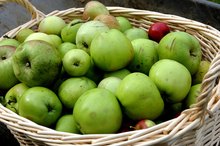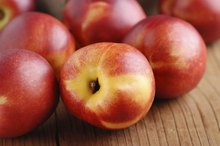Low Phosphorus, Potassium & Sodium Menus
Chronic kidney disease patients have dietary restrictions for phosphorus, potassium and sodium 1. Kidney disease is when your kidneys are unable to excrete wastes efficiently and regulate water and other chemicals in your body. High levels of phosphorous, potassium and sodium can cause high blood pressure, weak bones and nerve damage, according to the National Kidney Foundation 124. Dietary changes can keep kidney disease from getting worse.
Foods Low in Phosphorus
Phosphorous and calcium are needed to build strong healthy bones. With kidney disease, your kidneys cannot remove the excess phosphorous very well. The National Kidney Foundation notes that too much phosphorous lowers levels of calcium in your bones, causing your bones to weaken 124. If your phosphorous levels are too high, substitute lower phosphorous foods.
- Phosphorous and calcium are needed to build strong healthy bones.
- With kidney disease, your kidneys cannot remove the excess phosphorous very well.
Foods Low in Potassium
Foods to Lower Potassium Levels
Learn More
Potassium helps with muscle contraction and regulates the heartbeat. Unhealthy kidneys can not balance the amount of potassium in your body 4. To reduce potassium in high potassium foods, cut fresh vegetables such as potatoes into 1/8 inch thick slices and soak them in warm water for two hours. Low potassium foods include:
- breads
- graham crackers
- rice
- popcorn
- cereal
- green beans
- canned beets
- cabbage
- coleslaw
- cucumber
- apples
- fruit cocktail
- canned pears
- pineapple
- raspberries
- cheese
- eggs
- Potassium helps with muscle contraction and regulates the heartbeat.
- To reduce potassium in high potassium foods, cut fresh vegetables such as potatoes into 1/8 inch thick slices and soak them in warm water for two hours.
Low Sodium Cooking
Puffiness, swollen ankles and shortness of breath can result from extra sodium and fluid buildup in your body. The best way to reduce sodium is to use herbs and spices, such as rosemary or curry, instead of sodium when cooking foods. Choose foods that have 35 mg or less for very low sodium, or 140 mg or less for low sodium.
Eating Out Smartly
How to Lower Sodium Levels in the Blood Naturally
Learn More
Find a restaurant that has a variety of menu items. Skip appetizers and order foods that are either broiled or grilled. Request that your meal be prepared with no or lower salt seasonings and with sauce and gravy on the side. Drink mostly water, but you can also have non-cola drinks such as ginger ale, sprite, lemonade and tea.
- Find a restaurant that has a variety of menu items.
- Skip appetizers and order foods that are either broiled or grilled.
Warning
Other foods to be cautious of are foods high in oxalates and purines. These foods contribute to kidney stone growth and increased blood and urinary uric acid levels, according to the Neprhology Physicians, LLC clinic 3. Foods high in oxalates are plant based and include boiled broccoli, boiled brussels sprouts, boiled cabbage, raw cucumber and boiled cauliflower. Purines are found in animal-based foods such as:
- anchovies
- sardines
- haddock
- herring
- mackerel
- ocean perch
- shrimp
- Other foods to be cautious of are foods high in oxalates and purines.
- These foods contribute to kidney stone growth and increased blood and urinary uric acid levels, according to the Neprhology Physicians, LLC clinic 3.
Related Articles
References
- National Kidney Foundation: What is Chronic Kidney Disease
- National Kidney Foundation: Phosphorous and Your CKD Diet
- Nephrology Physicians, LLC : Kidney and Renal Food Lists
- National Kidney Foundation: Potassium and Your CKD Diet
- Nephrology Physicians, LLC: Pre-Dialysis Nutrition
- Cleveland Clinic. Kidney Failure. Last Reviewed January 10, 2018.
- Potpara TS, Jokic V, Dagres N, et al. Cardiac Arrhythmias in Patients with Chronic Kidney Disease: Implications of Renal Failure for Antiarrhythmic Drug Therapy. Curr Med Chem. 2016;23(19):2070-83. doi:10.1093/eurheartj/ehy060
- Centers for Disease Control. National Chronic Kidney Disease Fact Sheet. 2017. Published 2017.
- Kazancioğlu R. Risk factors for chronic kidney disease: an update. Kidney Int Suppl (2011). 2013;3(4):368-371. doi:10.1038/kisup.2013.79
- National Institute of Diabetes and Digestive and Kidney Diseases. Choosing a Treatment for Kidney Failure. Published January 2018.
- Kim, D., Kim, M, Kim, H. et al. Early Referral to a Nephrologist Improved Patient Survival: Prospective Cohort Study for End-Stage Renal Disease in Korea. PLoS One. 2013. 8(1):e55323.
- Smart, N., and T. Titus. Outcomes of Early versus Late Nephrology Referral in Chronic Kidney Disease: A Systematic Review. American Journal of Medicine. 2011. 124(11):1073-80.e2.
- Smart, N., Dieberg, G., Ladhani, M., and T. Titus. Early Referral to Specialist Nephrology Services for Preventing Progression to End-Stage Kidney Disease. Cochrane Database for Systematic Reviews. 2014. (6):CD007333.
Writer Bio
Charmaine Jones began freelance writing in 2010, specializing in health, diet and nutrition. She has experience with writing and editing grants and has written publications for nonprofit organizations. Jones holds a Master of Public Health in health promotion from the University of South Carolina.








